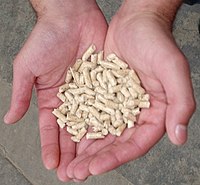
Photo from wikipedia
OBJECTIVE Utilization of liquid smoke rice husk can be used as an alternative treatment because of the antimicrobial properties. Advances in drug delivery systems are increasingly developing to increase the… Click to show full abstract
OBJECTIVE Utilization of liquid smoke rice husk can be used as an alternative treatment because of the antimicrobial properties. Advances in drug delivery systems are increasingly developing to increase the bioavailability of drugs and reduce the side effects of these drugs, namely nanoparticles. In this study, nanoparticles of liquid smoke rice husk (nLSRH) were tested the antimicrobial against Porphyromonas gingivalis. MATERIALS AND METHOD This type of research is an experimental in vitro laboratory using Porphyromonas gingivalis culture. nLSRH contained liquid smoke rice husk concentration of 1, 2.5, 5, 7.5, 10, 12.5, 15, and 17.5%. The antibacterial was performed using the dilution methods. RESULTS The nLRSH concentration of 1% showed clearest medium. The highest number of colonies Porphyromonas gingivalis was observed at nLSRH concentration of 1% (40.3 colony-forming unit [CFU]) and decreased at a concentration of 2.5% (11.3 CFU); other concentration or no bacterial colony growth was found. The nLSRH concentration of 2.5% can be determined as the minimum inhibitory concentration and nLSRH concentration of 5% can be determined as the minimum bactericidal concentration. CONCLUSION nLSRH have antimicrobial activity against Porphyromonas gingivalis. This finding able to drive the next research to develop nLSRH as gingival and periodontitis disease is caused by Porphyromonas gingivalis.
Journal Title: European journal of dentistry
Year Published: 2022
Link to full text (if available)
Share on Social Media: Sign Up to like & get
recommendations!